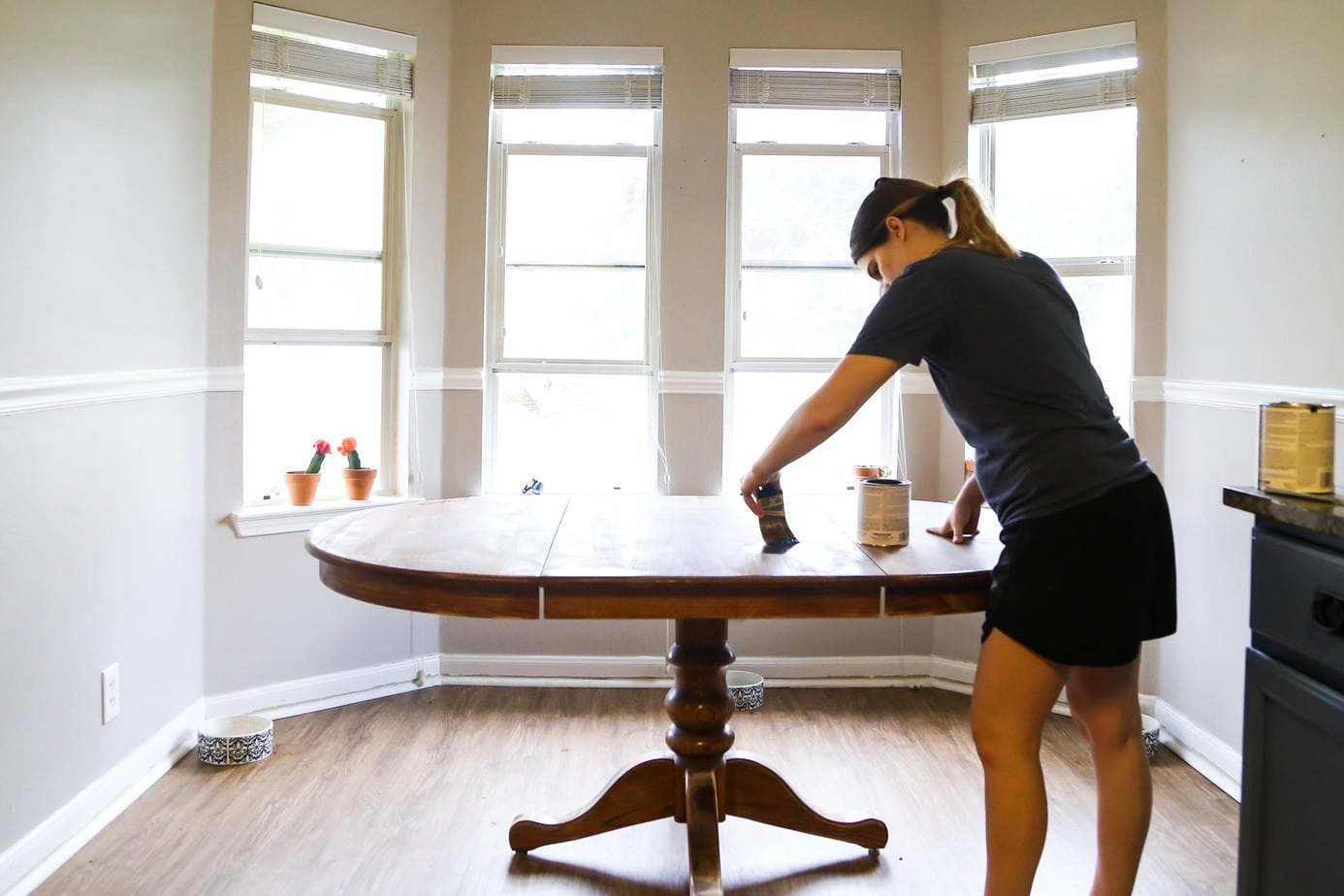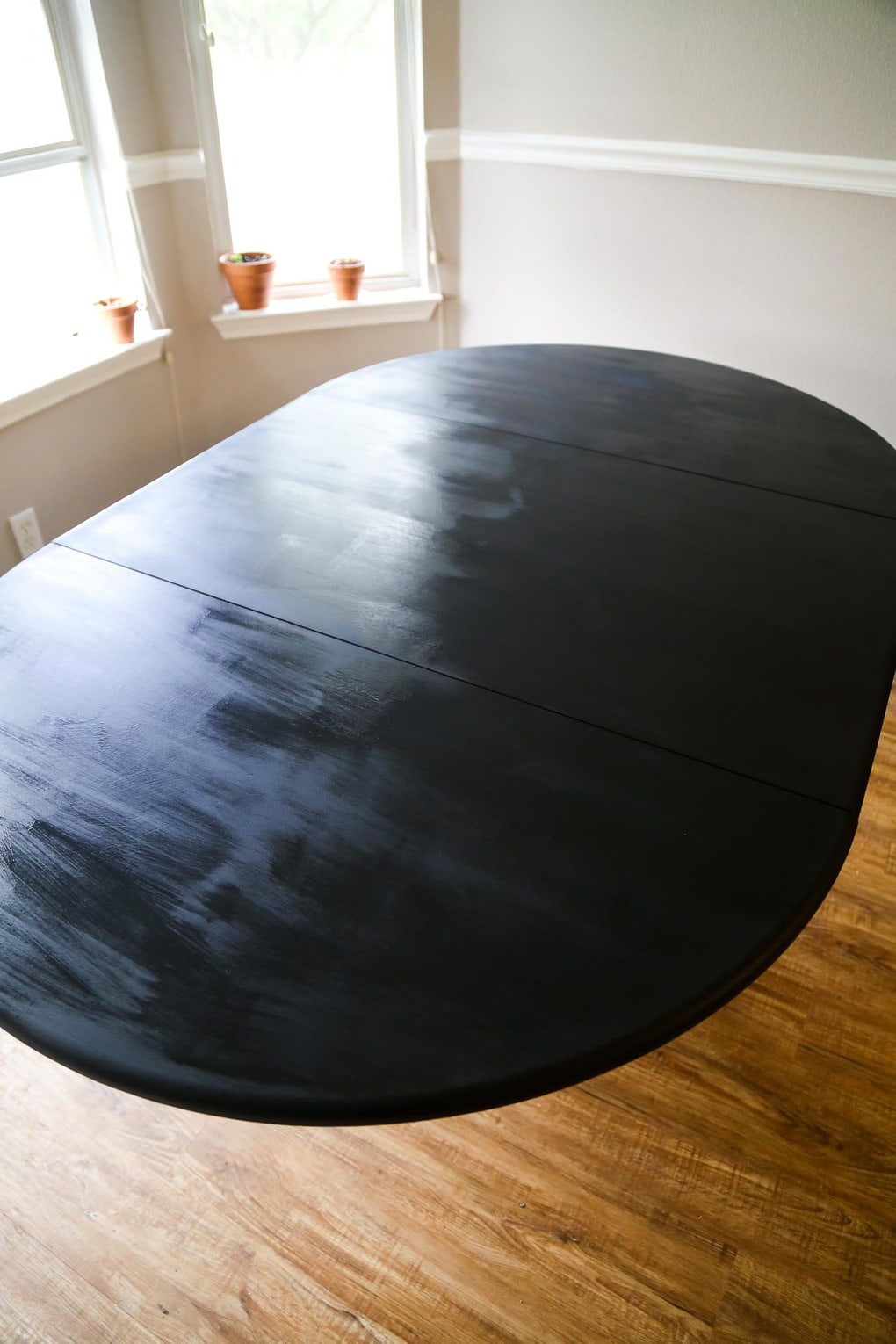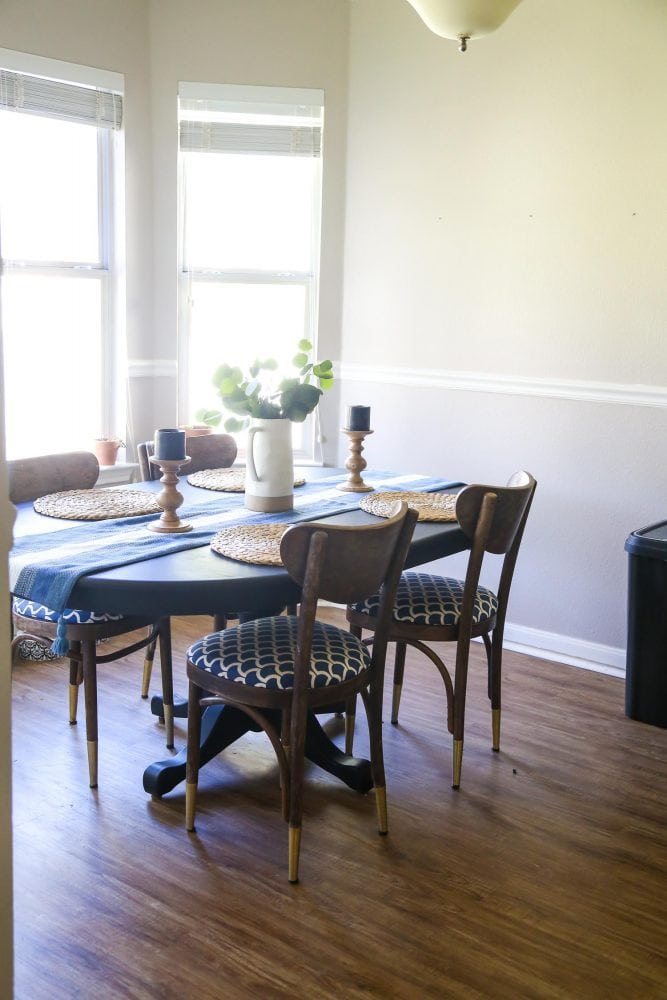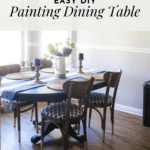Milk Paint Dining Table Makeover
Have you ever asked yourself, “what is milk paint?” I know I did all the time before this project! We recently gave our dining room table a makeover with milk paint, and our new painted dining room table is so gorgeous – I can’t get enough! This post is sponsored by Rust-Oleum.
It seems a little ridiculous to actually admit this out loud, but I’m a home decor and DIY blogger who, up until this week, had never used either chalk paint or milk paint.
What am I even doing with my life?
I’ll admit – both chalk paint and milk paint have previously seemed to not really be my style. I feel like you most often see these kinds of paint used in more farmhouse-style homes, or on rustic, chipped furniture. Neither of those are styles I tend to gravitate to, so it has seemed pointless to try it out.
So, when my friends at Rust-Oleum asked if I’d be interested in giving their milk paint finish a try for a project around the house, I knew I had to say yes – it was high time I stepped out of my comfort zone a bit and saw what all the fuss was about. And, y’all, I’m so glad I did.

Gorgeous, right?!
I promise I’ll get into all of the details of why we chose this table and what we think about the paint, but first I want to dive a little deeper into milk paint in general because, I have to admit, before doing this project I didn’t really know anything about it. So, here are the three questions I asked myself before I got started, along with what I’ve learned with a bit of research.
What is Milk Paint?
Milk paint is a water-based paint that is generally made with milk and lime, with pigments mixed in for color. You’ll often find milk paint in powdered form, and you have to add water to activate the paint. Rust-Oleum, however, has (thankfully) done all of the work for you and their Milk Paint Finish comes in a liquid form – you can just open the can and get to painting!
Why Would I Use Milk Paint?
- The prep work is minimal. Rust-Oleum’s Milk Paint Finish is formulated to have higher adhesion power than regular old paint, which means you don’t have to do nearly as much work on the front end to make sure you get a good finish. In fact, if you’re looking for that chippy, rustic look on your piece, you can generally just whip out a paintbrush and get to work without sanding.
- The finish is very durable. Contrary to what I originally believed, milk paint doesn’t always chip over time. The finish on Rust-Oleum’s Milk Paint Finish is extremely durable and should be able to withstand a lot of wear and tear.
- You don’t need to worry about brush strokes. Can I get a hallelujah?! One of the biggest pains when it comes to painting is having to break out the foam roller, spend a ton of time watching for brush strokes, and dealing with the annoying clean up that rollers bring with them. That’s why I usually reach for my paint sprayer instead. Spraying furniture just feels so much faster. But with milk paint, you’re actually supposed to just use a brush, and you’re really supposed to embrace the brush strokes.
What’s the difference between Rust-Oleum’s Chalked Paint and Milk Paint Finish?
Please allow me to confess that for a very long time I had no clue that these two types of paint weren’t the same thing. In reality, chalk paint and milk paint are actually very different and provide very different results. Here are a few key differences between Rust-Oleum’s Chalked Paint and Milked Paint Finish:
- Chalk paint provides a velvety, smooth finish, while milk paint’s finish is lightly textured with some brush strokes.
- Chalk paint has a more opaque coverage (you can generally achieve full coverage with just one coat). Milk paint provides a bit more control over the opacity of the coverage.
- Chalk paint tends to hide any wood grain or imperfections in your piece, while milk paint can highlight it. You really can’t see this with my finished piece because I opted for extra coverage. But, as I was working on the first two coats, it was interesting to see how the wood grain still showed through the paint’s finish. Milk paint provides a lot of flexibility with allowing the beauty of your wood piece to still shine.
I hope that helps explain milk paint and how it works a bit. I always find it really helpful to learn about new types of paint! For me, I can definitely see this paint being really useful when I want a less polished-feeling piece of furniture. Or, when I’m looking for a matte finish on something. I’m also dying to play around with adding fewer coats to see how the wood grain can really shine.
But, enough technical details. Let’s chat about our table.
Our DIY Painted Dining Table

This is what our table looked like before. We snagged this table for about $100 on Craigslist shortly after we moved into this house. We needed something large enough to fill this space, but cheap enough that we wouldn’t kick ourselves if we changed our minds down the road. This table has served us well over the last few months.
Except for the part where it’s kind of ugly.
I mean, the shape of the table really is perfectly fine. We like the pedestal base, and the oval shape works well in this space. But the orange-y finish and cheap-looking wood? Not cute.
So, paint it was! Here’s how I did it:
How I Painted Our Dining Room Table
Step One: Prep
Before you get start, you’ll want to clean your table. Remove any dust or grim, clean off the tabletop and legs and anything you plan to paint.
Then, you’ll need to sand. I used my power sander and 120-grit sandpaper just to scuff up the surface and remove any sheen from the old finish on the table. If you have a table that’s already been painted, you may need to sand a little more.
If you’re planning to work with latex paint, I recommend adding a couple of coats of primer prior to getting started. The milk paint was really flexible and didn’t need it. But, adding primer is always a good idea before a fresh coat of paint.
Step Two: Get Painting
For this specific furniture paint, I was able to just use a paintbrush. If you want a smoother finish with no texture or brush strokes, I recommend using a latex paint and a paint sprayer!
I’d estimate that it took me about 15 minutes to get each coat of paint on the table. With the particular paint I used, you only have to wait 30 minutes after the first coat to apply the next.

As far as timing, I got started on the table after dropping Jack at school at 9:00 one morning. I was finished, showered, and settled in on the couch to get some work done by lunchtime. It doesn’t get much better than that!
I did three light coats of paint on my table. Here’s how it looked after the third coat had been applied and was drying.

Step Three: Seal
After I was done with the milk paint, I gave the paint a full 8 hours to dry. Once it had plenty of cure time, it was time for the top coat. I used Rust-Oleum’s Chalked Protective Topcoat in the Matte finish. Many other milk paints require a wax, and a regular latex paint would do well with polyurethane. As long as you’re applying some sort of clear coat to protect things, you’re good! I recommend checking the instructions of any top coat you choose to make sure it’s compatible with your paint.
Sealing is key if you want a longer-lasting finish, especially on the table top where it gets lots of use!

I can officially say that I’m a milk paint convert. I’m already brainstorming other places that I can use this paint. If you’re curious, be sure to check out Rust-Oleum’s line of milk paint finish. If you’ve been wanting to paint some furniture but are a little nervous about actually diving in and trying it, milk paint is a great way to get your feet wet and give it a shot!
Our new painted dining table is bringing me a ton of joy. This was a really easy and satisfying DIY project, and I can hardly believe it’s the same old table!



Hi, I know that I’m a little late reading your post😂, but I love it! Did you paint the legs as well? Thanks
Yes, I did!
I love the look of this table! I know this was posted a few years ago now and I’m curious how it has held up for you?
Hi! It held up really well for us over time!
What about a glass of water with moisture sitting on top of the table top for half hour
That will leave a mark on most wood or painted surfaces. I’m sure there are some simple solutions for removing water stains, though!
I need some input on painting a metal table. It has a glass top an gold metal legs an trim. I want to do it silver, but not sure if I should sand it an what kind of paint to use. Thank you
Hi, Marlene – Generally with metal furniture I suggest you use spray paint. If it has peeling paint on it, I’d use a paint stripper to remove it, but if it doesn’t you can just lightly sand to scuff up the surface.
Can you tell me did you sand after th final coat of milk paint and before the chalked top coat?
Hi Debra! Normally I do, but I didn’t with this paint – since it has such a matte, chalky finish and I wasn’t looking for a distressed finish, I left it alone.
Thanks for posting this! I was sooo afraid to paint my kitchen table but it was either that or pay big bucks for a new set. I used the eclipse milk paint and it was so easy and I love the finished product!! I love the brush strokes and how the wood shows through! Now I have the courage to do the chairs too! Thanks again!
Noelle, I’m SO glad to hear you love it! Comments like this always make my day – thanks so much for sharing!
Excellent presentation on clalk paint, thank you for the information. I look forward to playing with chalk paint on the near future.
Nice job! Your table looks great and fits your criteria!
I’m so excited to try this on our dining room table as well! Trying to decide if I should try it on my daughters dresser as well or go with the chalkpaint. Thanks for the info and tutorial. I’m excited to try so hopefully I won’t have to cover it with a tablecloth anymore!
Hope it works well for you! I really love the texture of this paint!
Hi!
How has the finish of your table held up in the first month?
Cheers,
Jean
Beautifully! We’ve had our fair share of spills (even a few that were forgotten for a few hours), crumbs, and other general life insanity and we have had absolutely no issues with it. I just use an all-purpose cleaning spray to wipe it down and it still looks great so far!
Can you share what you use to clean the table top after use?
I use just water to clean my table most of hte time, but when it needs a deeper clean I just use any gentle spray cleaner
This is exactly what I was looking for! Your table turned out amazing and I’m now convinced painting my table black is the way to go!
I just found your blog and I’m hooked! The farmhouse style is getting a little worn out so your style is refreshing and just what I was looking for.
Thank you so much for your kind words, Lisa!! So glad the tutorial is helpful!
Your table looks gorgeous! That color is perfect and I have to say, I’m in love with your chairs! Thanks so much for sharing your makeover with us at Merry Monday this week!
Thanks so much!
I don’t love chalk or milk paint, but I do love how this table turned out! Black was definitely the way to go!
Thanks so much, Kala!
Love this! I’ve been thinking about painting our farmhouse table black.
Question – does the protective coat make it wipeable? That’s one of my reservations with painting a dining room table.
Hi Jilli – I actually just painted it this week so I haven’t had a ton of time to let it get super dirty yet. That being said, we have eaten a few meals on it and I’ve had no problems wiping it down afterwards! I’ll have to do an update in a few months to let y’all know how it’s holding up – it sees a LOT of use on a day-to-day basis, so we’ll definitely be putting it through a solid test!